Module 6 A trip to the zoo 模块表格式教案(5课时)
文档属性
| 名称 | Module 6 A trip to the zoo 模块表格式教案(5课时) | 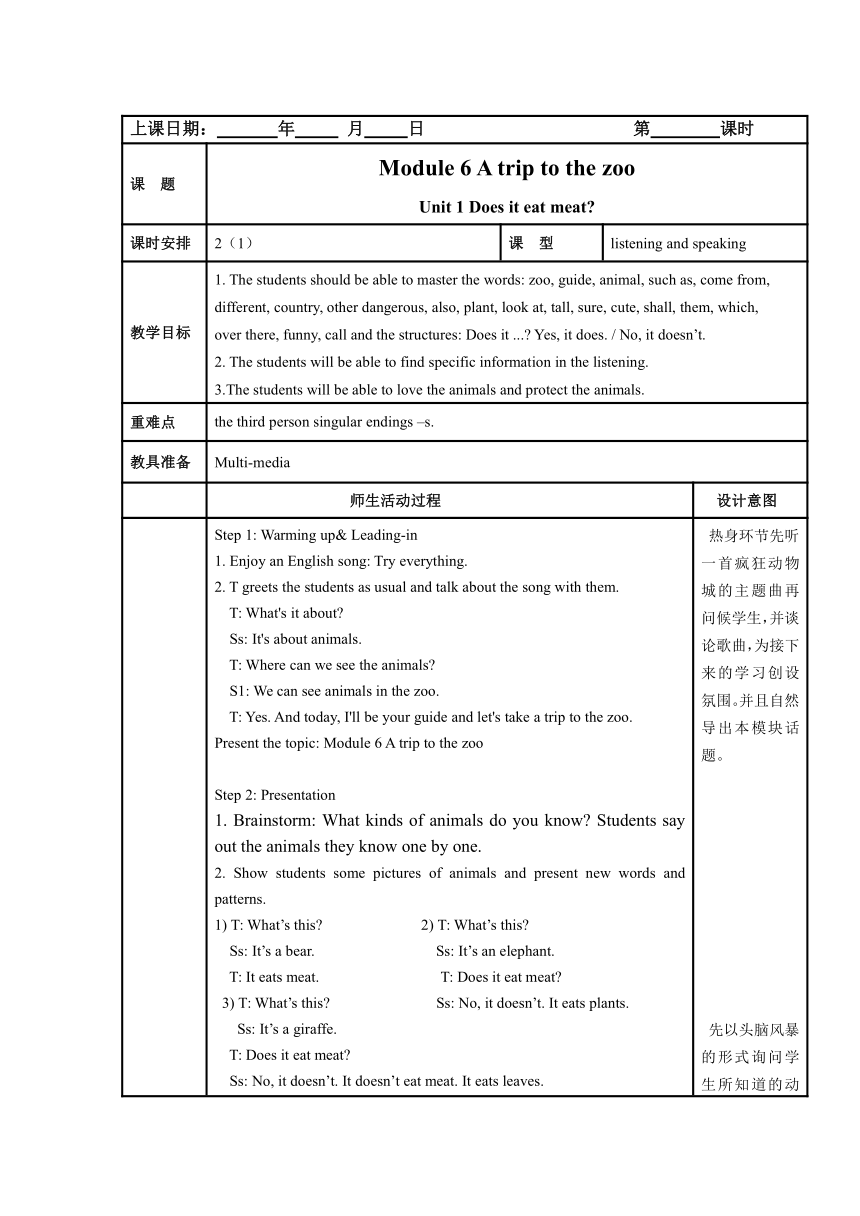 | |
| 格式 | docx | ||
| 文件大小 | 55.3KB | ||
| 资源类型 | 试卷 | ||
| 版本资源 | 外研版 | ||
| 科目 | 英语 | ||
| 更新时间 | 2022-09-29 09:52:44 | ||
图片预览

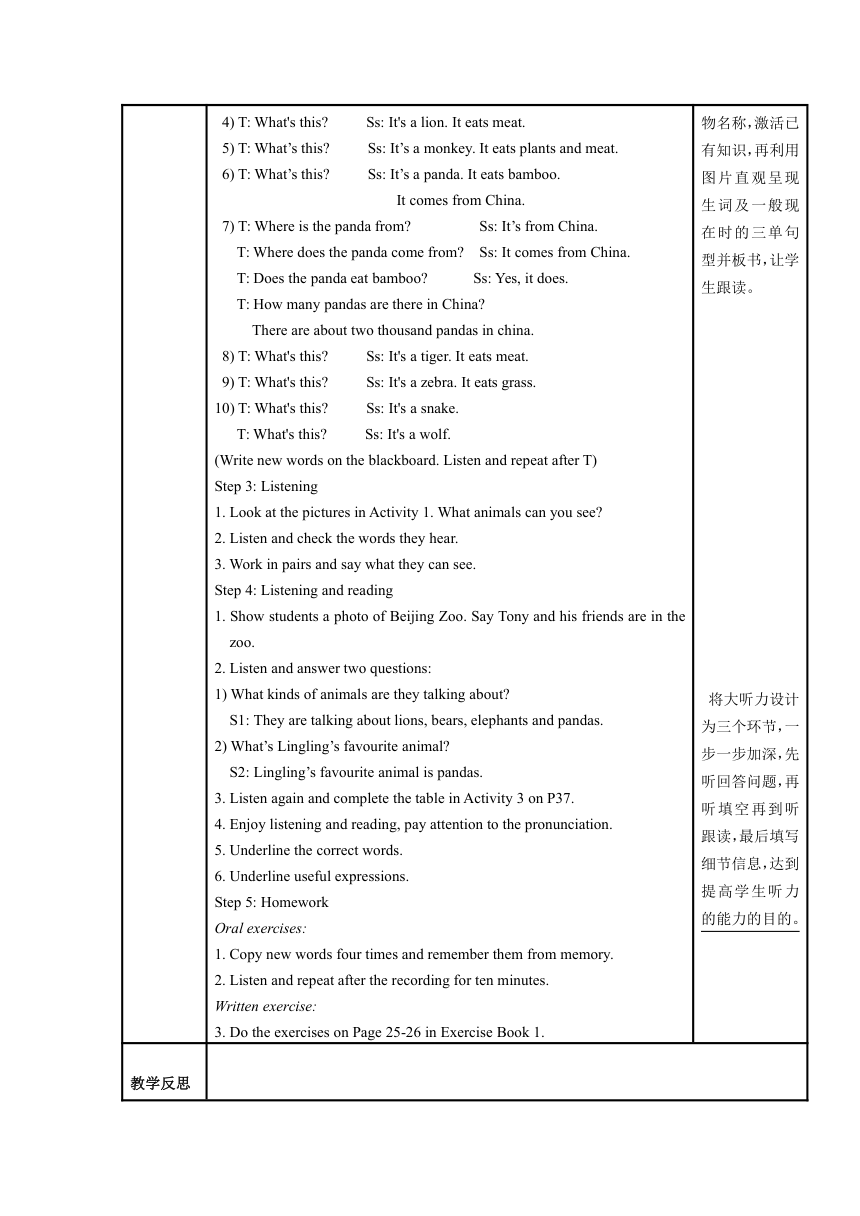
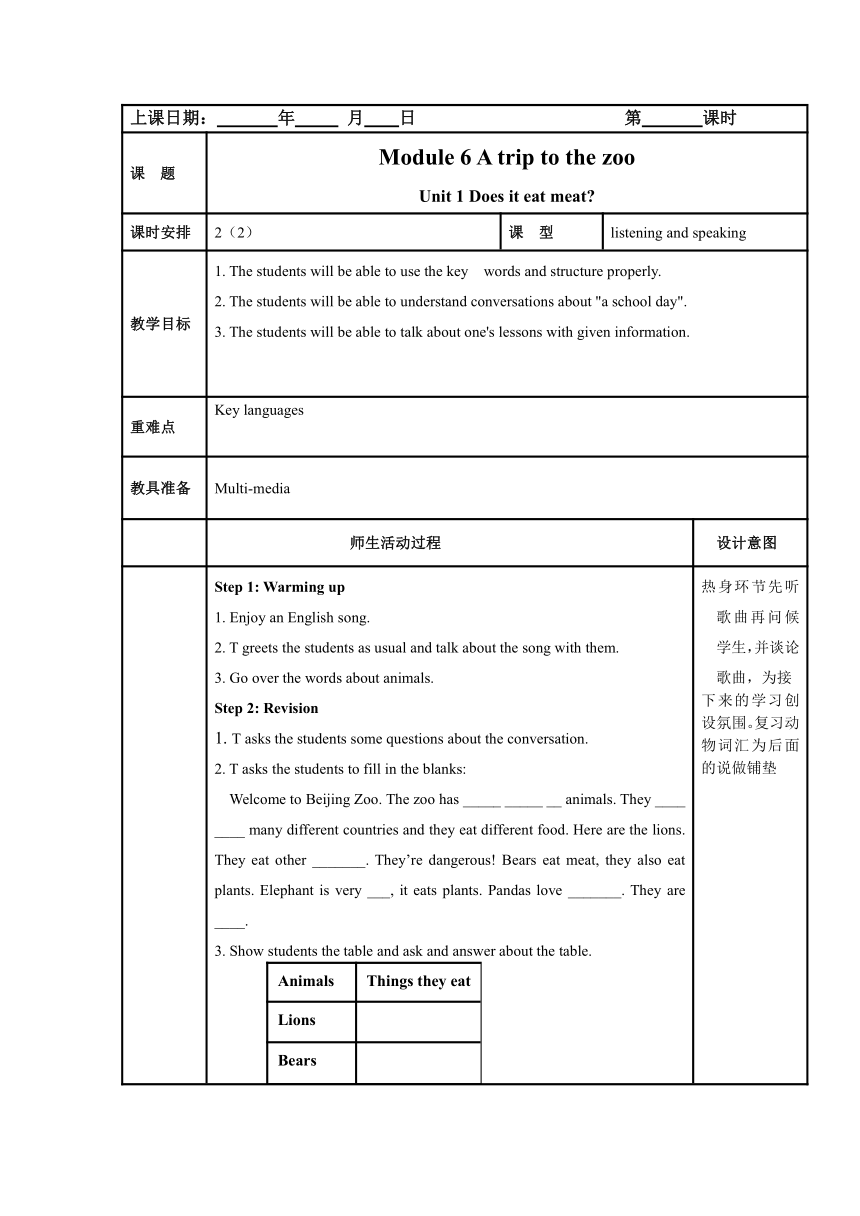
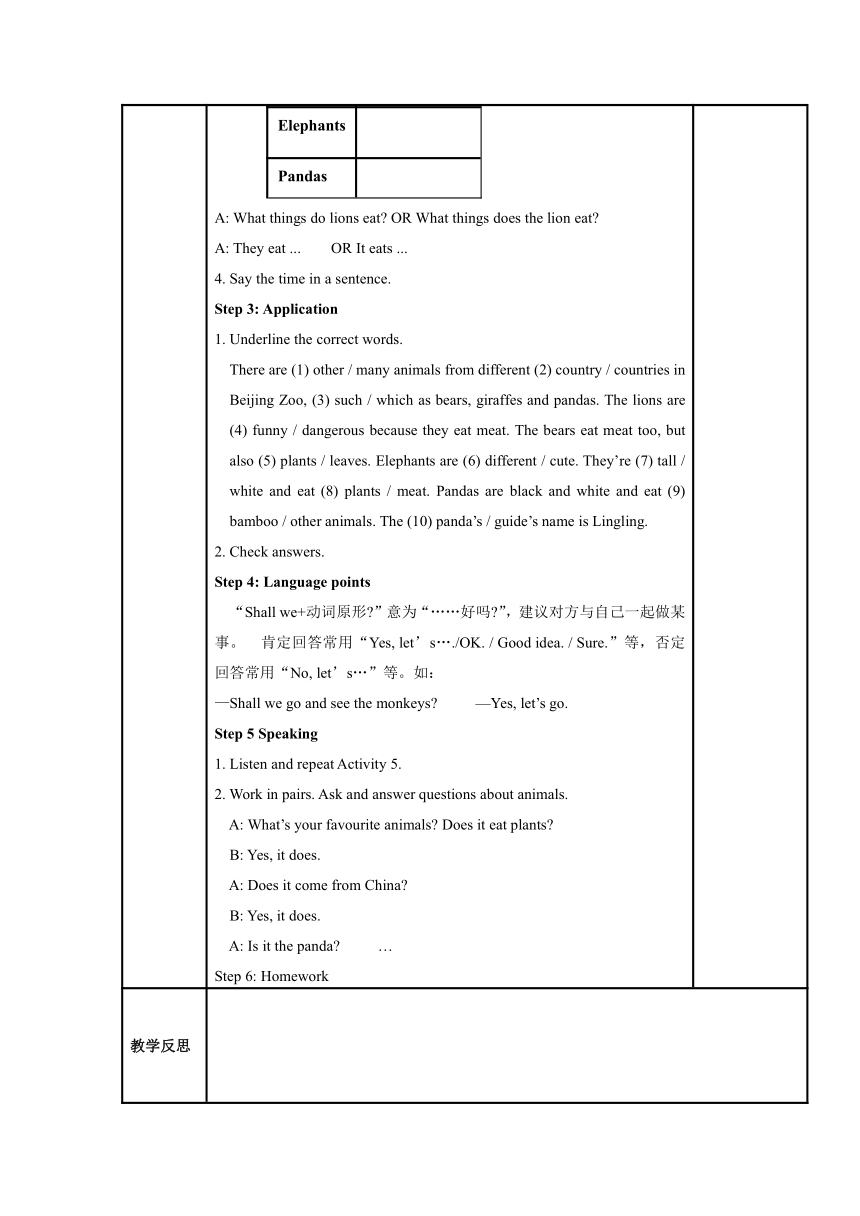
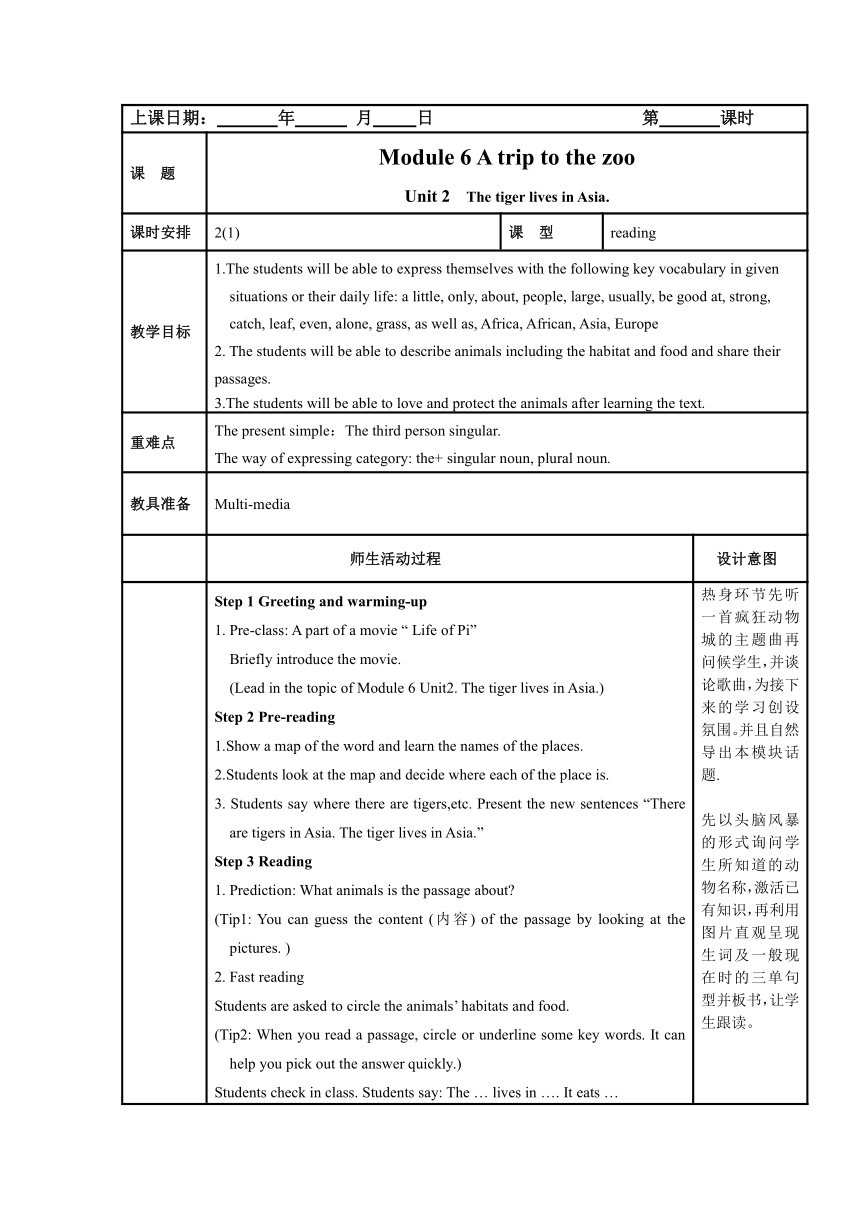
文档简介
上课日期: 年 月 日 第 课时
课 题 Module 6 A trip to the zoo Unit 1 Does it eat meat
课时安排 2(1) 课 型 listening and speaking
教学目标 1. The students should be able to master the words: zoo, guide, animal, such as, come from, different, country, other dangerous, also, plant, look at, tall, sure, cute, shall, them, which, over there, funny, call and the structures: Does it ... Yes, it does. / No, it doesn’t. 2. The students will be able to find specific information in the listening. 3.The students will be able to love the animals and protect the animals.
重难点 the third person singular endings –s.
教具准备 Multi-media
师生活动过程 设计意图
Step 1: Warming up& Leading-in 1. Enjoy an English song: Try everything. 2. T greets the students as usual and talk about the song with them. T: What's it about Ss: It's about animals. T: Where can we see the animals S1: We can see animals in the zoo. T: Yes. And today, I'll be your guide and let's take a trip to the zoo. Present the topic: Module 6 A trip to the zoo Step 2: Presentation 1. Brainstorm: What kinds of animals do you know Students say out the animals they know one by one. 2. Show students some pictures of animals and present new words and patterns. 1) T: What’s this 2) T: What’s this
Ss: It’s a bear. Ss: It’s an elephant. T: It eats meat. T: Does it eat meat 3) T: What’s this Ss: No, it doesn’t. It eats plants. Ss: It’s a giraffe. T: Does it eat meat
Ss: No, it doesn’t. It doesn’t eat meat. It eats leaves.
4) T: What's this Ss: It's a lion. It eats meat. 5) T: What’s this Ss: It’s a monkey. It eats plants and meat. 6) T: What’s this Ss: It’s a panda. It eats bamboo. It comes from China.
7) T: Where is the panda from Ss: It’s from China.
T: Where does the panda come from Ss: It comes from China.
T: Does the panda eat bamboo Ss: Yes, it does.
T: How many pandas are there in China
There are about two thousand pandas in china.
8) T: What's this Ss: It's a tiger. It eats meat.
9) T: What's this Ss: It's a zebra. It eats grass. 10) T: What's this Ss: It's a snake. T: What's this Ss: It's a wolf. (Write new words on the blackboard. Listen and repeat after T) Step 3: Listening 1. Look at the pictures in Activity 1. What animals can you see
2. Listen and check the words they hear. 3. Work in pairs and say what they can see. Step 4: Listening and reading 1. Show students a photo of Beijing Zoo. Say Tony and his friends are in the zoo. 2. Listen and answer two questions: 1) What kinds of animals are they talking about
S1: They are talking about lions, bears, elephants and pandas. 2) What’s Lingling’s favourite animal
S2: Lingling’s favourite animal is pandas. 3. Listen again and complete the table in Activity 3 on P37. 4. Enjoy listening and reading, pay attention to the pronunciation. 5. Underline the correct words. 6. Underline useful expressions. Step 5: Homework Oral exercises: 1. Copy new words four times and remember them from memory. 2. Listen and repeat after the recording for ten minutes. Written exercise: 3. Do the exercises on Page 25-26 in Exercise Book 1. 热身环节先听一首疯狂动物城的主题曲再问候学生,并谈论歌曲,为接下来的学习创设氛围。并且自然导出本模块话题。 先以头脑风暴的形式询问学生所知道的动物名称,激活已有知识,再利用图片直观呈现生词及一般现在时的三单句型并板书,让学生跟读。 将大听力设计为三个环节,一步一步加深,先听回答问题,再听填空再到听跟读,最后填写细节信息,达到提高学生听力的能力的目的。
教学反思
上课日期: 年 月 日 第 课时
课 题 Module 6 A trip to the zoo Unit 1 Does it eat meat
课时安排 2(2) 课 型 listening and speaking
教学目标 1. The students will be able to use the key words and structure properly. 2. The students will be able to understand conversations about "a school day". 3. The students will be able to talk about one's lessons with given information.
重难点 Key languages
教具准备 Multi-media
师生活动过程 设计意图
Step 1: Warming up 1. Enjoy an English song. 2. T greets the students as usual and talk about the song with them. 3. Go over the words about animals. Step 2: Revision 1. T asks the students some questions about the conversation. 2. T asks the students to fill in the blanks: Welcome to Beijing Zoo. The zoo has _____ _____ __ animals. They ____ ____ many different countries and they eat different food. Here are the lions. They eat other _______. They’re dangerous! Bears eat meat, they also eat plants. Elephant is very ___, it eats plants. Pandas love _______. They are ____. 3. Show students the table and ask and answer about the table. AnimalsThings they eatLionsBearsElephantsPandas
A: What things do lions eat OR What things does the lion eat A: They eat ... OR It eats ... 4. Say the time in a sentence. Step 3: Application 1. Underline the correct words.
There are (1) other / many animals from different (2) country / countries in Beijing Zoo, (3) such / which as bears, giraffes and pandas. The lions are (4) funny / dangerous because they eat meat. The bears eat meat too, but also (5) plants / leaves. Elephants are (6) different / cute. They’re (7) tall / white and eat (8) plants / meat. Pandas are black and white and eat (9) bamboo / other animals. The (10) panda’s / guide’s name is Lingling. 2. Check answers. Step 4: Language points “Shall we+动词原形 ”意为“……好吗 ”,建议对方与自己一起做某事。 肯定回答常用“Yes, let’s…./OK. / Good idea. / Sure.”等,否定回答常用“No, let’s…”等。如: —Shall we go and see the monkeys —Yes, let’s go. Step 5 Speaking 1. Listen and repeat Activity 5. 2. Work in pairs. Ask and answer questions about animals.
A: What’s your favourite animals Does it eat plants
B: Yes, it does.
A: Does it come from China
B: Yes, it does.
A: Is it the panda … Step 6: Homework 热身环节先听歌曲再问候学生,并谈论歌曲,为接 下来的学习创设氛围。复习动物词汇为后面的说做铺垫
教学反思
上课日期: 年 月 日 第 课时
课 题 Module 6 A trip to the zoo Unit 2 The tiger lives in Asia.
课时安排 2(1) 课 型 reading
教学目标 1.The students will be able to express themselves with the following key vocabulary in given situations or their daily life: a little, only, about, people, large, usually, be good at, strong, catch, leaf, even, alone, grass, as well as, Africa, African, Asia, Europe 2. The students will be able to describe animals including the habitat and food and share their passages. 3.The students will be able to love and protect the animals after learning the text.
重难点 The present simple:The third person singular. The way of expressing category: the+ singular noun, plural noun.
教具准备 Multi-media
师生活动过程 设计意图
Step 1 Greeting and warming-up 1. Pre-class: A part of a movie “ Life of Pi” Briefly introduce the movie. (Lead in the topic of Module 6 Unit2. The tiger lives in Asia.) Step 2 Pre-reading 1.Show a map of the word and learn the names of the places. 2.Students look at the map and decide where each of the place is. 3. Students say where there are tigers,etc. Present the new sentences “There are tigers in Asia. The tiger lives in Asia.” Step 3 Reading 1. Prediction: What animals is the passage about (Tip1: You can guess the content (内容) of the passage by looking at the pictures. ) 2. Fast reading Students are asked to circle the animals’ habitats and food. (Tip2: When you read a passage, circle or underline some key words. It can help you pick out the answer quickly.) Students check in class. Students say: The … lives in …. It eats … Students learn some new words and expressions, such as “as well as, a little, a day, leaf, grass, even”. 3. Careful reading 1. Students read the passage carefully and answer the questions. 1).Are there many pandas in China now 2).Which animal likes water 3).Does the tiger live together 4).Which animal is the favourite of people all over the world Students learn some words and expression: only, alone, be good at 2. Students complete the sentences with the correct form of the words and expressions from the box. (Tips3:Think about what type of words they go with and cross out the words in the box as you work.) Tell the students to pay attention to the capital letters. 4. Post reading 1. Students introduce the animals according to the word map. (Tip4: A word map can you help you memorise the main information.) 2. Students design a name card for an animal. Share their cards with their classmates. Step 4 Homework Oral exercises: 1.Finish your introduction of an animal. Exchange with your classmates to share. 2.Read the passage and try to retell it. Written exercise: 热身环节先听一首疯狂动物城的主题曲再问候学生,并谈论歌曲,为接下来的学习创设氛围。并且自然导出本模块话题. 先以头脑风暴的形式询问学生所知道的动物名称,激活已有知识,再利用图片直观呈现生词及一般现在时的三单句型并板书,让学生跟读。 先说图片中所看到的动物,再听降低听的难度,再小组操练所学动物单词。 将大听力设 为三个环节,一步一步加深,先听回答问题,再听填空再到听跟读,最后填写细节信息,达到提高学生听力的能力的目的
教学反思
上课日期: 年 月 日 第 课时
课 题 Module 6 A trip to the zoo Unit 2 The tiger lives in Asia.
课时安排 2(2) 课 型 Reading and writing
教学目标 1.The students will be able to master the key structures: There are …in Asia../ The elephant lives in … 2.The students will be able to describe animals including the habitat and food and share their passages. 3. The students will be able to love and protect the animals after learning the text.
重难点 1.To get information from the reading material about animals and the related information 2. Key languages
教具准备 Multi-media
师生活动过程 设计意图
Step 1 Greeting and warming-up 1. Pre-class: Enjoy an English song Briefly introduce the song and greet the students. Step 2 Brainstorming 1.Say out the animals they have learnt and they know. 2.The teacher asks the students where they live and what they eat. Step 3 Before-writing 1. The teacher asks the students where do these animals live. 2. The teacher asks the students what do these animals eat. 3. The teacher asks the students what do these animals look like. 4. The teacher asks the students what these animals like. Step 4: Writing 1. The teacher asks the students to write key words in the table. Name kangaroo giraffe… Home Food Appearance Hobby
2. Students write sentences according to the table. 3. Students write a passage according to the sentences. An example: My favourite animal is the kangaroo. It lives in Australia. It eats grass and leaves, but it doesn’t eat meat. It has a strong tail and back legs. So it is good at jumping. I like it because it is interesting to have a pocket on the front of its body. Step 5 Language points 1. The elephant lives in Africa and in Asia.
表示“一类”: ① the +名词复数② a + 名词单数③ 名词复数 2. The panda eats about 30 kilos of bamboo a day, as well as plants and leaves. as well as 意为“并且,还”,常用来连接并列的单词或 短语。 3. It likes water and is good at swimming. be good at 意为“在……方 面 (学得, 做得) 好、擅长……”, 其后可接名词、代词或动词的 -ing形式, 其近义词组为 do well in。 Step 6: Homework Oral exercises: 1. Remember new words from memory 2. Read the passage and try to retell it. Written exercises: 3. Do the exercises on Page 31-32 in Exercise Book 2. 4. Make your writing better.
教学反思
上课日期: 年 月 日 第 课时
课 题 Module 6 A trip to the zoo Unit 3 Language in use
课时安排 1 课 型 revision
教学目标 1. The students will be able to ask and answer questions about animals with the interrogative form of the present simple. 2.The students will be able to introduce animals.
重难点 The present simple:The third person singular. The way of expressing category: the+ singular noun, plural noun.
教具准备 Multi-media
师生活动过程 设计意图
Step 1: Warming up& Leading-in 1. Enjoy an English song: Try everything. 2. T greets the students as usual and talk about the song with them. Step 2: Retelling 1. Brainstorm: Show students the word map(the world of animals). 2. Ask several students to retell the information about these animals: The elephant lives in Africa and Asia. It eats plants and fruit. It likes water. The panda lives in China. It is black and white. It eats bamboo. There are only 1,800 pandas in China. The monkey lives in Africa, Asia and America. There are about 200 kinds of monkeys. Monkeys eat meat, leaves, fruit and even eggs. The tiger lives in Asia. It lives alone. It catches many kinds of animals for food. It likes water and it's good at swimming. The zebra lives in Africa. It eats leaves as well as grass. Step 3: Pairwork 1. Work in pairs. Look at the pictures. Ask and answer.
A: Does Meimei the elephant come from Yunnan, China B: Yes, it does. A: Does Kingba the tiger come from America B: No, it doesn’t. It comes from Asia. A: Does Kingba eat meat B: Yes, it does. It eats meat. 2. Show students some other pictures about animals. Work in pairs. Step 4: Application 1. Do Activity 2.Complete the sentences with does or doesn't. 2. Do Activity 3. Complete the passage with the correct form of the words in brackets. 3. Complete the word map. Step 5: Around the world T asks questions about the two animals. Help students understand it. 1) Where does the camel live 2)What does the camel eat 3)Does it carry water in the humps on its back 4)Where does the kangaroo live 5)What does the kangaroo eat 6)Does it carry water in a pocket on the front of its body Step 6: Homework Oral exercises: Remember the key vocabulary and phrases from memory. Written exercise: Do the exercises on Page 26-27 in Exercise Book 2. 热身环节先听一首疯狂动物城的主题曲再问候学生,并谈论歌曲,为接下来的学习创设氛围。 先以头脑风暴的形式,以及文本相关信息询问学生所知道的动物名称及习性,利用word map让学生复述课文。 小组操练问答练习,有了头脑风暴的铺垫,学生操作顺畅,平板同屏学生无需抬头看屏幕便于小组合作的进行。 运用平板达到写的目的,并且通过学生上传作业,直接并同时进行4位学生的作品展示,省时高效。 作业分口头和书面作业满足学生不同层面的需求。
教学反思
课 题 Module 6 A trip to the zoo Unit 1 Does it eat meat
课时安排 2(1) 课 型 listening and speaking
教学目标 1. The students should be able to master the words: zoo, guide, animal, such as, come from, different, country, other dangerous, also, plant, look at, tall, sure, cute, shall, them, which, over there, funny, call and the structures: Does it ... Yes, it does. / No, it doesn’t. 2. The students will be able to find specific information in the listening. 3.The students will be able to love the animals and protect the animals.
重难点 the third person singular endings –s.
教具准备 Multi-media
师生活动过程 设计意图
Step 1: Warming up& Leading-in 1. Enjoy an English song: Try everything. 2. T greets the students as usual and talk about the song with them. T: What's it about Ss: It's about animals. T: Where can we see the animals S1: We can see animals in the zoo. T: Yes. And today, I'll be your guide and let's take a trip to the zoo. Present the topic: Module 6 A trip to the zoo Step 2: Presentation 1. Brainstorm: What kinds of animals do you know Students say out the animals they know one by one. 2. Show students some pictures of animals and present new words and patterns. 1) T: What’s this 2) T: What’s this
Ss: It’s a bear. Ss: It’s an elephant. T: It eats meat. T: Does it eat meat 3) T: What’s this Ss: No, it doesn’t. It eats plants. Ss: It’s a giraffe. T: Does it eat meat
Ss: No, it doesn’t. It doesn’t eat meat. It eats leaves.
4) T: What's this Ss: It's a lion. It eats meat. 5) T: What’s this Ss: It’s a monkey. It eats plants and meat. 6) T: What’s this Ss: It’s a panda. It eats bamboo. It comes from China.
7) T: Where is the panda from Ss: It’s from China.
T: Where does the panda come from Ss: It comes from China.
T: Does the panda eat bamboo Ss: Yes, it does.
T: How many pandas are there in China
There are about two thousand pandas in china.
8) T: What's this Ss: It's a tiger. It eats meat.
9) T: What's this Ss: It's a zebra. It eats grass. 10) T: What's this Ss: It's a snake. T: What's this Ss: It's a wolf. (Write new words on the blackboard. Listen and repeat after T) Step 3: Listening 1. Look at the pictures in Activity 1. What animals can you see
2. Listen and check the words they hear. 3. Work in pairs and say what they can see. Step 4: Listening and reading 1. Show students a photo of Beijing Zoo. Say Tony and his friends are in the zoo. 2. Listen and answer two questions: 1) What kinds of animals are they talking about
S1: They are talking about lions, bears, elephants and pandas. 2) What’s Lingling’s favourite animal
S2: Lingling’s favourite animal is pandas. 3. Listen again and complete the table in Activity 3 on P37. 4. Enjoy listening and reading, pay attention to the pronunciation. 5. Underline the correct words. 6. Underline useful expressions. Step 5: Homework Oral exercises: 1. Copy new words four times and remember them from memory. 2. Listen and repeat after the recording for ten minutes. Written exercise: 3. Do the exercises on Page 25-26 in Exercise Book 1. 热身环节先听一首疯狂动物城的主题曲再问候学生,并谈论歌曲,为接下来的学习创设氛围。并且自然导出本模块话题。 先以头脑风暴的形式询问学生所知道的动物名称,激活已有知识,再利用图片直观呈现生词及一般现在时的三单句型并板书,让学生跟读。 将大听力设计为三个环节,一步一步加深,先听回答问题,再听填空再到听跟读,最后填写细节信息,达到提高学生听力的能力的目的。
教学反思
上课日期: 年 月 日 第 课时
课 题 Module 6 A trip to the zoo Unit 1 Does it eat meat
课时安排 2(2) 课 型 listening and speaking
教学目标 1. The students will be able to use the key words and structure properly. 2. The students will be able to understand conversations about "a school day". 3. The students will be able to talk about one's lessons with given information.
重难点 Key languages
教具准备 Multi-media
师生活动过程 设计意图
Step 1: Warming up 1. Enjoy an English song. 2. T greets the students as usual and talk about the song with them. 3. Go over the words about animals. Step 2: Revision 1. T asks the students some questions about the conversation. 2. T asks the students to fill in the blanks: Welcome to Beijing Zoo. The zoo has _____ _____ __ animals. They ____ ____ many different countries and they eat different food. Here are the lions. They eat other _______. They’re dangerous! Bears eat meat, they also eat plants. Elephant is very ___, it eats plants. Pandas love _______. They are ____. 3. Show students the table and ask and answer about the table. AnimalsThings they eatLionsBearsElephantsPandas
A: What things do lions eat OR What things does the lion eat A: They eat ... OR It eats ... 4. Say the time in a sentence. Step 3: Application 1. Underline the correct words.
There are (1) other / many animals from different (2) country / countries in Beijing Zoo, (3) such / which as bears, giraffes and pandas. The lions are (4) funny / dangerous because they eat meat. The bears eat meat too, but also (5) plants / leaves. Elephants are (6) different / cute. They’re (7) tall / white and eat (8) plants / meat. Pandas are black and white and eat (9) bamboo / other animals. The (10) panda’s / guide’s name is Lingling. 2. Check answers. Step 4: Language points “Shall we+动词原形 ”意为“……好吗 ”,建议对方与自己一起做某事。 肯定回答常用“Yes, let’s…./OK. / Good idea. / Sure.”等,否定回答常用“No, let’s…”等。如: —Shall we go and see the monkeys —Yes, let’s go. Step 5 Speaking 1. Listen and repeat Activity 5. 2. Work in pairs. Ask and answer questions about animals.
A: What’s your favourite animals Does it eat plants
B: Yes, it does.
A: Does it come from China
B: Yes, it does.
A: Is it the panda … Step 6: Homework 热身环节先听歌曲再问候学生,并谈论歌曲,为接 下来的学习创设氛围。复习动物词汇为后面的说做铺垫
教学反思
上课日期: 年 月 日 第 课时
课 题 Module 6 A trip to the zoo Unit 2 The tiger lives in Asia.
课时安排 2(1) 课 型 reading
教学目标 1.The students will be able to express themselves with the following key vocabulary in given situations or their daily life: a little, only, about, people, large, usually, be good at, strong, catch, leaf, even, alone, grass, as well as, Africa, African, Asia, Europe 2. The students will be able to describe animals including the habitat and food and share their passages. 3.The students will be able to love and protect the animals after learning the text.
重难点 The present simple:The third person singular. The way of expressing category: the+ singular noun, plural noun.
教具准备 Multi-media
师生活动过程 设计意图
Step 1 Greeting and warming-up 1. Pre-class: A part of a movie “ Life of Pi” Briefly introduce the movie. (Lead in the topic of Module 6 Unit2. The tiger lives in Asia.) Step 2 Pre-reading 1.Show a map of the word and learn the names of the places. 2.Students look at the map and decide where each of the place is. 3. Students say where there are tigers,etc. Present the new sentences “There are tigers in Asia. The tiger lives in Asia.” Step 3 Reading 1. Prediction: What animals is the passage about (Tip1: You can guess the content (内容) of the passage by looking at the pictures. ) 2. Fast reading Students are asked to circle the animals’ habitats and food. (Tip2: When you read a passage, circle or underline some key words. It can help you pick out the answer quickly.) Students check in class. Students say: The … lives in …. It eats … Students learn some new words and expressions, such as “as well as, a little, a day, leaf, grass, even”. 3. Careful reading 1. Students read the passage carefully and answer the questions. 1).Are there many pandas in China now 2).Which animal likes water 3).Does the tiger live together 4).Which animal is the favourite of people all over the world Students learn some words and expression: only, alone, be good at 2. Students complete the sentences with the correct form of the words and expressions from the box. (Tips3:Think about what type of words they go with and cross out the words in the box as you work.) Tell the students to pay attention to the capital letters. 4. Post reading 1. Students introduce the animals according to the word map. (Tip4: A word map can you help you memorise the main information.) 2. Students design a name card for an animal. Share their cards with their classmates. Step 4 Homework Oral exercises: 1.Finish your introduction of an animal. Exchange with your classmates to share. 2.Read the passage and try to retell it. Written exercise: 热身环节先听一首疯狂动物城的主题曲再问候学生,并谈论歌曲,为接下来的学习创设氛围。并且自然导出本模块话题. 先以头脑风暴的形式询问学生所知道的动物名称,激活已有知识,再利用图片直观呈现生词及一般现在时的三单句型并板书,让学生跟读。 先说图片中所看到的动物,再听降低听的难度,再小组操练所学动物单词。 将大听力设 为三个环节,一步一步加深,先听回答问题,再听填空再到听跟读,最后填写细节信息,达到提高学生听力的能力的目的
教学反思
上课日期: 年 月 日 第 课时
课 题 Module 6 A trip to the zoo Unit 2 The tiger lives in Asia.
课时安排 2(2) 课 型 Reading and writing
教学目标 1.The students will be able to master the key structures: There are …in Asia../ The elephant lives in … 2.The students will be able to describe animals including the habitat and food and share their passages. 3. The students will be able to love and protect the animals after learning the text.
重难点 1.To get information from the reading material about animals and the related information 2. Key languages
教具准备 Multi-media
师生活动过程 设计意图
Step 1 Greeting and warming-up 1. Pre-class: Enjoy an English song Briefly introduce the song and greet the students. Step 2 Brainstorming 1.Say out the animals they have learnt and they know. 2.The teacher asks the students where they live and what they eat. Step 3 Before-writing 1. The teacher asks the students where do these animals live. 2. The teacher asks the students what do these animals eat. 3. The teacher asks the students what do these animals look like. 4. The teacher asks the students what these animals like. Step 4: Writing 1. The teacher asks the students to write key words in the table. Name kangaroo giraffe… Home Food Appearance Hobby
2. Students write sentences according to the table. 3. Students write a passage according to the sentences. An example: My favourite animal is the kangaroo. It lives in Australia. It eats grass and leaves, but it doesn’t eat meat. It has a strong tail and back legs. So it is good at jumping. I like it because it is interesting to have a pocket on the front of its body. Step 5 Language points 1. The elephant lives in Africa and in Asia.
表示“一类”: ① the +名词复数② a + 名词单数③ 名词复数 2. The panda eats about 30 kilos of bamboo a day, as well as plants and leaves. as well as 意为“并且,还”,常用来连接并列的单词或 短语。 3. It likes water and is good at swimming. be good at 意为“在……方 面 (学得, 做得) 好、擅长……”, 其后可接名词、代词或动词的 -ing形式, 其近义词组为 do well in。 Step 6: Homework Oral exercises: 1. Remember new words from memory 2. Read the passage and try to retell it. Written exercises: 3. Do the exercises on Page 31-32 in Exercise Book 2. 4. Make your writing better.
教学反思
上课日期: 年 月 日 第 课时
课 题 Module 6 A trip to the zoo Unit 3 Language in use
课时安排 1 课 型 revision
教学目标 1. The students will be able to ask and answer questions about animals with the interrogative form of the present simple. 2.The students will be able to introduce animals.
重难点 The present simple:The third person singular. The way of expressing category: the+ singular noun, plural noun.
教具准备 Multi-media
师生活动过程 设计意图
Step 1: Warming up& Leading-in 1. Enjoy an English song: Try everything. 2. T greets the students as usual and talk about the song with them. Step 2: Retelling 1. Brainstorm: Show students the word map(the world of animals). 2. Ask several students to retell the information about these animals: The elephant lives in Africa and Asia. It eats plants and fruit. It likes water. The panda lives in China. It is black and white. It eats bamboo. There are only 1,800 pandas in China. The monkey lives in Africa, Asia and America. There are about 200 kinds of monkeys. Monkeys eat meat, leaves, fruit and even eggs. The tiger lives in Asia. It lives alone. It catches many kinds of animals for food. It likes water and it's good at swimming. The zebra lives in Africa. It eats leaves as well as grass. Step 3: Pairwork 1. Work in pairs. Look at the pictures. Ask and answer.
A: Does Meimei the elephant come from Yunnan, China B: Yes, it does. A: Does Kingba the tiger come from America B: No, it doesn’t. It comes from Asia. A: Does Kingba eat meat B: Yes, it does. It eats meat. 2. Show students some other pictures about animals. Work in pairs. Step 4: Application 1. Do Activity 2.Complete the sentences with does or doesn't. 2. Do Activity 3. Complete the passage with the correct form of the words in brackets. 3. Complete the word map. Step 5: Around the world T asks questions about the two animals. Help students understand it. 1) Where does the camel live 2)What does the camel eat 3)Does it carry water in the humps on its back 4)Where does the kangaroo live 5)What does the kangaroo eat 6)Does it carry water in a pocket on the front of its body Step 6: Homework Oral exercises: Remember the key vocabulary and phrases from memory. Written exercise: Do the exercises on Page 26-27 in Exercise Book 2. 热身环节先听一首疯狂动物城的主题曲再问候学生,并谈论歌曲,为接下来的学习创设氛围。 先以头脑风暴的形式,以及文本相关信息询问学生所知道的动物名称及习性,利用word map让学生复述课文。 小组操练问答练习,有了头脑风暴的铺垫,学生操作顺畅,平板同屏学生无需抬头看屏幕便于小组合作的进行。 运用平板达到写的目的,并且通过学生上传作业,直接并同时进行4位学生的作品展示,省时高效。 作业分口头和书面作业满足学生不同层面的需求。
教学反思
同课章节目录
- Starte
- Module 1 My teacher and my friends
- Module 2 My English lesson
- Module 3 My English book
- Module 4 My everyday life
- Module 1 My classmates
- Unit 1 Nice to meet you.
- Unit 2 I'm Wang Lingling and I'm thirteen years ol
- Unit 3 Language in use.
- Module 2 My family
- Unit 1 Is this your mum?
- Unit 2 These are my parents.
- Unit 3 Language in use.
- Module 3 My school
- Unit 1 There are thirty students in my class.
- Unit 2 The library is on the left of the playgroun
- Unit 3 Language in use.
- Module 4 Healthy food
- Unit 1 We've got lots of apples.
- Unit 2 Is your food and drink healthy?
- Unit 3 Language in use.
- Module 5 My school day
- Unit 1 I love history.
- Unit 2 We start work at nine o'clock.
- Unit 3 Language in use.
- Revision module A
- Module 6 A trip to the zoo
- Unit 1 Does it eat meat?
- Unit 2 The tiger lives in Asia.
- Unit 3 Language in use.
- Module 7 Computers
- Unit 1 How do I write my homework on the computer?
- Unit 2 When do you use a computer?
- Unit 3 Language in use.
- Module 8 Choosing presents
- Unit 1 I always like birthday parties.
- Unit 2 She often goes to concerts.
- Unit 3 Language in use.
- Module 9 People and places
- Unit 1 We're enjoying the school trip a lot.
- Unit 2 They're waiting for buses or trains.
- Unit 3 Language in use.
- Module 10 Spring Festival
- Unit 1 Are you getting ready for Spring Festival?
- Unit 2 My mother's cleaning our houses and sweepin
- Unit 3 Language in use.
- Revision module B
